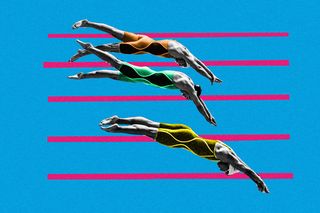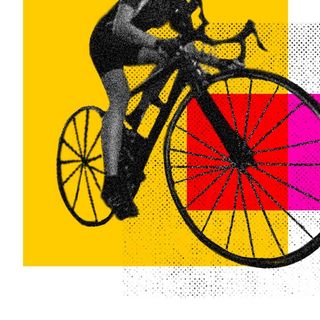
World Swimming Body Bans Trans Athletes From Women’s Events
Trans women will not be allowed to compete if they experienced male puberty after the age of 12, a restriction that may exclude many from elite sports.

In March this year, Lia Thomas made history as the first known trans woman to win the highest college swimming title in the U.S. Thomas’s record-breaking victory was divisive, to say the least: while some celebrated the success and called her a trailblazer, others strongly condemned Thomas’s participation in a women’s event.
The fierce support and objection have resulted in the events of today: on Sunday, the world’s governing swimming body, International Swimming Federation (Fina), effectively banned trans athletes from participating in women’s events — if they experienced “male” puberty after the age of 12.
The swimming body’s decision is seismic and consequential: it makes swimming the second Olympic sport with an official ban against trans people from participating in women’s sports, citing “scientific reasons” (Rugby did something similar last year). Fina’s jurisdiction applies to competitions across swimming, water polo, diving, artistic swimming and open water swimming, and high diving.
Fina has now voted to restrict trans athletes’ access to women’s swimming competitions under the specified conditions, a vote that was passed with 71% majority from 152 Fina members. The 34-page report from the scientific panel argued that trans women carried an advantage over cisgender female swimmers, even after reducing their testosterone levels through medication. Fina’s revised guidelines that come into effect from Monday thus assert that male-to-female transitioning athletes could now compete in the women’s category only “provided they have not experienced any part of male puberty beyond Tanner Stage 2 [which marks the start of physical development], or before age 12, whichever is later.” The group said its policy — which is by far the strictest of any Olympic governing body — is based on consultation and feedback from athletic, scientific, and legal experts.
Fina’s president, Husain al-Musallam, justifies the decision as follows: “We have to protect the rights of our athletes to compete, but we also have to protect competitive fairness at our events, especially the women’s category at Fina competitions.” People supporting such a policy argue that those who have gone through male puberty have physical advantages and it is thus unfair for others in women’s competitions.
In other words, the governing body is pitting people’s right to compete with the overall bid to ensure “competitive fairness.” Its ban, then, seemingly prioritized protecting the latter. This is among sports’ biggest debates, one juxtaposing trans persons’ inclusion with fairness and framing the two as equal priorities in the world within and beyond sports.
Related on The Swaddle:
Olympic Guidelines No Longer Require Trans Women to Have Low Testosterone Levels
The semantics of the ban identify male puberty as a landmark point in this conversation. Sports have used testosterone limits as a basis for laying out the eligibility of trans women to compete in the women’s category. The link between testosterone to greater athletic ability is tenuous, with research struggling to identify a causal relationship between the two. “For every credible study and statement out there that proves greater testosterone is linked to greater athletic ability in men and women, there are equally credible studies that prove testosterone is just one of the many factors that affect sporting ability — sometimes even negatively,” Pallavi Prasad noted in her article in The Swaddle in 2020.
What’s more concerning is the age limit that Fina has identified. Restricting trans athletes who have transitioned after 12 years of age effectively means banning trans athletes from women’s events in general. “To require transgender athletes to ‘complete’ a medical transition by age 12 – particularly when it is increasingly difficult & in some states nearly impossible to get gender-affirming care – is outrageous & completely unrealistic,” athlete Chris Mosier noted.
Moreover, the age of puberty varies among people, making 12 years a decisive marker quite arbitrary. “Where did that 12 come from? Is that a specific age that everybody is supposed to have passed through puberty, because it may not be the case,” Dr. Alireza Hamidian Jahromi, co-director of the Gender Affirmation Surgery Center at Temple University Hospitals in Philadelphia, told AP. Moreover, the guidelines are also worryingly vague about what they mean by “transitioning.” Dr. Hamidian Jahromi points out the three stages of transitioning: social, medical involving hormones, and surgical. That athletes would have undergone surgery by the age of 12 is “almost impossible,” he said.
One way to also understand the debate is to question the idea of male puberty and its link to athletic prowess. What makes Michael Phelps the best swimmer in the world? Is it the flexibility, body shape, or his proportionally longer “wingspan”? All of the above; his body is anatomically different from everyone else’s. Height and other physical markers may not intrinsically promise success by themselves, but they hint at an advantage over others. What this means is people are born with natural advantages all the time; that trans athletes may have an upper hand becomes a tedious argument in the broader scheme of things.
Related on The Swaddle:
This ban, though, essentially means trans women will be excluded from elite sports. Athlete Ally, an LGBT advocacy group, called the new policy “discriminatory, harmful, unscientific and not in line with the 2021 IOC [International Olympic Committee] principles.” Last year, the IOC released a new set of guidelines encouraging governing bodies to move away from using testosterone levels as a measure for including trans athletes. No athlete, the IOC noted, has an inherent advantage because of who they are.
“The eligibility criteria for the women’s category as it is laid out in the policy polices the bodies of all women, and will not be enforceable without seriously violating the privacy and human rights of any athlete looking to compete in the women’s category,” said Anne Lieberman, the group’s director of policy and programs. Currently, there are no trans women in elite swimming competitions, according to AP. As Mosier noted, the new policy may result in more policing of women’s bodies in swimming.
Why Lieberman and other activists also call this move “discriminatory” is because Fina, for now, said it will create an “open category” for trans women in some events under its new guidelines. The promise of a separate category is rife with challenges of its own: this is a future offering that leaves trans women in an abyss for now. Athletes like Lia Thomas are now debarred from participating in world swimming competitions including the Olympics. The decision to restrict trans women’s entry was made without thinking of, let alone fleshing out, the workings of a separate category.
Moreover, who constitutes the working group to decide how to set up a new open category will also determine just how fair and “inclusive” the new policy purports to be.
Last week, the International Cycling Union (UCI) also decided to impose stricter limits for trans athletes. The body doubled the period of time before a rider can compete in women’s races, while also reducing the maximum accepted levels of testosterone.
It is impossible to ignore the context to which such restrictions are being set up for trans women athletes. Surely the debate involves treading carefully along the lines of inclusion, safety, and sports fairness, but another tangent of note is also of prejudices, bigotry, and transphobia. Speaking of the tussle around what basic rights should apply to athletes, Louisa Thomas wrote in The New Yorker: “The argument about Lia Thomas, a college student from Texas in her early twenties, is also an argument about whether there are, finally, defining lines, and who gets to set them.”
Saumya Kalia is an Associate Editor at The Swaddle. Her journalism and writing explore issues of social justice, digital sub-cultures, media ecosystem, literature, and memory as they cut across socio-cultural periods. You can reach her at @Saumya_Kalia.
Related


An Indian Cyclist’s Sexual Abuse Complaint Shows How Power Dynamics Operate Within Sports
